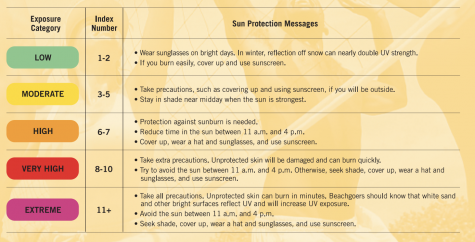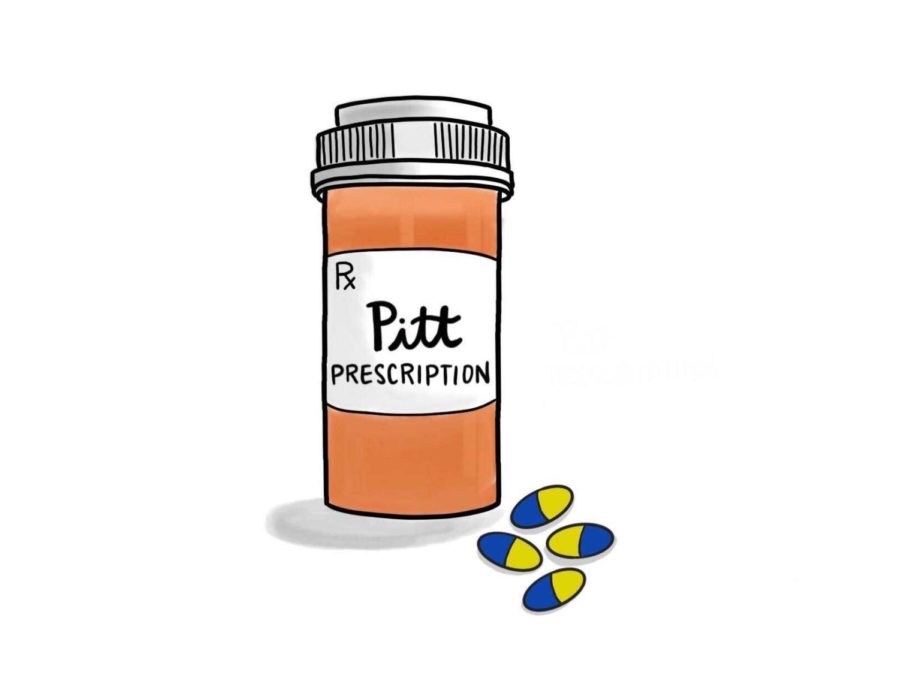The Pitt Prescription | Self-care for the summertime sun
The Pitt Prescription is a biweekly blog where student pharmacist and senior staff writer Elizabeth Donnelly provides tips on how to stay healthy in college. This edition was reviewed by Karen S. Pater, PharmD., CDCES, BCACP.
Shruti Talekar | Contributing Editor
The Pitt Prescription
April 18, 2021
Summer is a great time for taking long hikes, going swimming or even just relaxing in the park while enjoying a good book, but there’s a silent threat present every time you go outdoors, especially in the warmer months — the sun.
The sun emits an invisible form of radiation called ultraviolet rays, of which there are three kinds — UVA rays may damage connective tissue and increase the risk for skin cancer, UVB rays penetrate the skin less than UVA rays but still may contribute to skin cancer and UVC rays are absorbed by the atmosphere and do not present a risk to people. These UV rays are present whenever the sun is out, even on cloudy days in the winter, but they pose more of a risk in the summer, typically because people are outside more often and wearing less protective clothing.
The sun’s UV rays can damage your skin in as little as 15 minutes of direct exposure, especially depending on the UV index for the day. Additionally, UV rays can damage your eyes, which is why light-protective sunglasses are a great option for coverage when outside. The National Weather Service and the U.S. Environmental Protection Agency developed the UV Index in 1994 to help lower the chances of Americans experiencing bad health effects from overexposure in the sun. The UV index is usually highest midday, from about 11 a.m. to 4 p.m., and it consists of five levels of UV ray exposure — low, moderate, high, very high and extreme. You can read more about the differentiations and recommendations for each level here.

Graphic from the U.S. Environmental Protection Agency’s “A Guide to the UV Index”
Over the summer, Pittsburgh’s monthly UV Index average typically stays within the high risk category. However, if you travel to more tropical locations or if you’re from the Southwest, then it is important to keep the very high and extreme precautions in mind.
How to choose the best sunscreen
If you are planning a (safe, socially distanced) summer trip or if you are from a location with a high UV Index, there are some key details you should know.
First, sunscreen is recommended for use whenever you are outside during the daytime. There are several daily moisturizers or creams that have SPF already included in them so that you can protect your skin, especially your facial skin, which is highly sensitive. I tend to use the Neutrogena SPF 50 daily moisturizer, but there are several other great brands to choose from — just make sure they offer protection against both UVA and UVB rays.
When it comes to body sunscreens, there are a couple of person-specific factors to take into account. Do you burn easily? Do you have light eyes and/or a history of freckling? Are you currently taking any medications that may make you more sensitive to the sun? If you answered yes to one or more of these questions, that may mean you are at a higher risk for sun damage and you require a stronger sunscreen.
A general recommendation is to use a sunscreen that protects against both UVA and UVB rays. The SPF of sunscreen, otherwise known as the sun protection factor, is what protects against UVB rays. The minimum protective SPF is 15, but the higher the SPF, the better UVB coverage. A sunscreen with SPF 50 has about 98% coverage against UVB rays, but no sunscreens offer 100% coverage. Sunburns are most commonly attributed to UVB rays, so a higher SPF means there is a smaller chance of you getting burnt.
For UVA protection, you should look for a sunscreen that is labeled as broad spectrum. UVA rays are more commonly associated with long-term skin damage and skin aging, but they still can contribute to sunburns. When choosing a sunscreen, it may help to look for ingredients like titanium dioxide or zinc oxide, as those are known agents that protect against UVA exposure.
It is also important to note the type of sunscreen product you are choosing from. Cream and lotion sunscreens are often considered the most effective. Spray sunscreens are still effective, but a user should thoroughly rub them into their skin for them to work properly. It should be noted that there is no such thing as choosing too protective of a sunscreen, but there is such a thing as choosing one that is not protective enough. It’s best to err on the side of caution and get a high SPF, broad spectrum product.
How to use sunscreen properly
This may come as a shock to some people, but sunscreen is pretty commonly misused. Sunscreen should be applied 15-30 minutes before leaving your house for maximum coverage. Then, it should be applied every two hours for the duration of the time you are outside. If you participate in sports, are in a humid environment or swim, then it is likely you will need to apply your sunscreen even more frequently than that, about every hour or so.
You should apply sunscreen liberally, putting a solid coat over every exposed part of your body. For most adults, this means you will apply about 1 ounce, or 30 milliliters, of sunscreen per application. To put this in perspective, one bottle of Banana Boat SPF 50 sunscreen is 8 ounces, which means that if you are spending the full day outside and you apply sunscreen 30 minutes before leaving and then every hour or two for the entire day, you should use almost the whole bottle in a single day.
How to care for a sunburn
Sun damage comes in many varieties, but one of the most commonly experienced is sunburns. Sunburns typically take a couple of hours to show up and they worsen over the course of about a day before starting to get better. Sunburns typically consist of red, tender, swollen skin (sometimes blistered) and may sometimes cause headaches, fever, nausea and fatigue.
The best way to stay safe is to take preventative measures, but if you do get a sunburn then you can ease the symptoms with several OTC products. Ibuprofen (Advil) can lessen the pain, fever and/or headache associated with the burn. Acetaminophen (Tylenol) may also be used but it has less of an anti-inflammatory effect compared to ibuprofen.
Additionally, applying unscented topical creams and alcohol-free gels may benefit the burned skin. It is important to look for products that do not contain alcohol as this ingredient could cause the skin to become dry and further irritated. If using aloe vera, it’s best to use the physical plant rather than a manufactured product. If you do not have access to the physical plant, look for natural products without alcohol or fragrances. You can also soothe burns with cool water, and you should drink water to stay hydrated as well. It is important not to expose the affected area to any more sun while healing, which can take up to five days. Sunburns are no fun, but with the right preventative care, you can enjoy the sun safely this summer.
Elizabeth writes primarily about self-care and pharmacological topics. You can reach her at [email protected].








